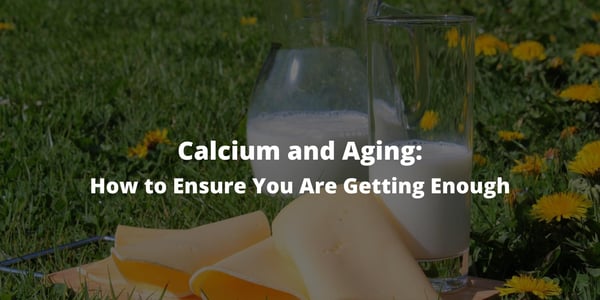Retirement is a time for you to enjoy yourself. Without a job or kids to take care of, you have all...
How to Increase Vitamin D Levels All Year
Vitamin D is a crucial nutrient that plays a vital role in several bodily functions, including bone health, immune system support, and regulation of mood. While it's commonly known as the "sunshine vitamin" because our skin produces it when exposed to sunlight, not everyone is able to get enough sun exposure to maintain optimal levels of vitamin D. Additionally, during the winter months, when the days are shorter and sunlight is scarce, it can be especially challenging to maintain healthy vitamin D levels. According to a study published in 2018, approximately 40% of Americans are vitamin D deficient. It has even been described as a global health problem and "An Ignored Epidemic". Therefore, it's important to be proactive and implement strategies to increase your vitamin D levels all year round.
In this blog post, we'll explore several effective ways to increase your vitamin D levels, regardless of the season. We'll discuss the benefits of vitamin D, the risks of vitamin D deficiency, and offer practical tips for maintaining optimal vitamin D levels. Whether you're concerned about the health risks associated with low vitamin D levels or simply want to support your overall well-being, this guide will provide you with the knowledge and tools you need to ensure you're getting enough of this crucial nutrient all year round.
Symptoms of Vitamin D Deficiency
Symptoms such as muscle weakness and bone pain may indicate vitamin D deficiency. Many people, however, experience just minor symptoms. Even if you don't have any symptoms, not getting enough vitamin D can harm your health.
Vitamin D Deficiency Tests
The most effective way for determining the vitamin D level in the body is the 25-hydroxy vitamin D test. For healthy individuals, a 20–50 nanograms/milliliter level is deemed sufficient. But if the level is less than 12 nanograms/milliliter, it shows that you are Vitamin D deficient.
How to Increase Vitamin D Levels
There following are simple ways to increase your vitamin D levels significantly:
Getting Vitamin D from the Sun

Expose yourself to the sun to get adequate vitamin D. When UVB rays from the sun strike your skin, they trigger a chemical process that leads to vitamin D production. Although the quantity of sun required to produce sufficient vitamin D varies, research suggests that to maintain enough vitamin D levels:
- Try to spend at least 5 to 30 minutes in the sun between 10 a.m. to 4 p.m. every day or twice-weekly.
- Let your face, arms, legs, and hands be exposed to the sun for this short period of time without using sunscreen.
For this process to work, direct sunlight is required—windows, clouds, smog, clothing, and sunscreen can block or reduce your skin's ability to absorb UVB rays.
Additionally, if you have darker skin, you may need to stay longer in the sun to get the same vitamin D level as those with lighter skin tones. People who have fair skin or are less than 50 convert sunlight into vitamin D much more proficiently than those who have darker skin or are greater than 50.
Once the sun's rays strike your skin and trigger the formation of a vitamin D precursor, it takes around eight hours for this forerunner to be transformed to vitamin D3. Vitamin D obtained from the sun has been shown to stay longer in the body than vitamin D obtained from diet or supplements.
Eat Vitamin D-Rich Foods
Although your body produces vitamin D in response to sunlight, you also require it through your diet. Therefore, increase your diet of vitamin D enrich foods if you wish to boost your vitamin D levels. The following foods may help you increase your vitamin D levels:
 Cod liver oil
Cod liver oil- Swordfish
- Salmon
- Sardines
- Mushrooms
- Egg yolk
- Beef liver
- Cheese
- Fortified cereals
- Fortified Tofu
- Vitamin D-fortified dairy products,
- Vitamin D-fortified orange juice
Fish liver oils and fatty fish flesh are two of the greatest vitamin D sources, while egg yolks, beef liver, and cheese have smaller amounts. Mushrooms are the sole vegetarian source of vitamin D. Egg yolk is an easy-to-incorporate vitamin D source.
Take Vitamin D Supplements
 Supplements may be the simplest and most effective way to boost vitamin D levels. Because of the risk of skin cancer linked with using sunlight to increase vitamin D levels and the difficulty in obtaining adequate vitamin D through diet, supplements are frequently the first line of defense for vitamin D deficient persons. Several multivitamin supplements contain vitamin D, but it is also available as a standalone supplement.
Supplements may be the simplest and most effective way to boost vitamin D levels. Because of the risk of skin cancer linked with using sunlight to increase vitamin D levels and the difficulty in obtaining adequate vitamin D through diet, supplements are frequently the first line of defense for vitamin D deficient persons. Several multivitamin supplements contain vitamin D, but it is also available as a standalone supplement.
Vitamin D exists in two primary biological forms D2 and D3. D2 is often derived from plants, while D3 is derived from animals. In a 2017 study, D3 is substantially more beneficial than D2 at maintaining and increasing overall vitamin D levels, so look for the supplements that contain this type. A daily dose of 1,000–4,000 IU is considered safe for maintaining healthy levels for most people. However, in other cases— particularly if your present levels are really low or you have inadequate exposure to sunlight — you may require a considerably higher dose.
It's best to consult your doctor before taking supplements to ensure that you're taking the correct dosage. It's also critical to get high-quality supplements that have undergone independent testing.
Use A UV Lamp
UV-B-emitting lamps can also help you get more vitamin D, albeit they can be expensive. Your skin can produce vitamin D on its own when exposed to radiation from the sun. UV lamps imitate the sun's action and could be especially beneficial if your exposure to the sun is limited owing to location or time spent indoors.
UV radiation has long been used to treat various skin problems, but it has only recently been promoted as a technique to increase vitamin D levels. However, safety is a major concern with these devices since excessive exposure might result in skin burns. So it is suggested to limit the exposure to 15 minutes at one time.
It is important to note that vitamin D is an essential nutrient. If a test shows that you are vitamin D deficient, you should visit a doctor to determine the right amount of vitamin D you should take to raise and maintain your levels.






